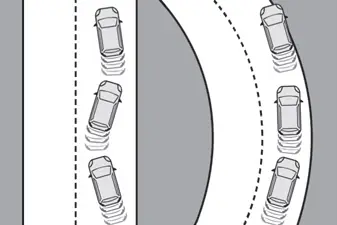Peugeot 308: Distraction detection
For more information, refer to the General recommendations on the use of driving and manoeuvring aids.
The function comprises the "Driver Attention Warning" system combined with the "Driver Attention Warning by Camera" system.
These systems are in no way designed to keep the driver awake or to prevent the driver from falling asleep at the wheel.
It is the driver's responsibility to stop if feeling tired.
Take a break if you are feeling tired or at least every 2 hours.
Driver Attention Warning
 The system triggers an alert
when it
detects that the driver has not taken a
break after two hours of driving at a speed above
43 mph (70 km/h).
The system triggers an alert
when it
detects that the driver has not taken a
break after two hours of driving at a speed above
43 mph (70 km/h).
This alert is issued via the display of a message encouraging the driver to take a break, accompanied by an audible signal.
If the driver does not follow this advice, the alert is repeated hourly until the vehicle is stopped.
The system resets itself if one of the following conditions is met:
- With the engine running, the vehicle has been stationary for more than 15 minutes.
- The ignition has been switched off for a few minutes.
- The driver's seat belt is unfastened and their door is opened.
As soon as the speed of the vehicle drops below 43 mph (70 km/h), the system goes into standby.
Driving time starts being counted again once the speed reaches above 43 mph (70 km/h).
Driver Attention Warning by Camera

 The system assesses the
driver's level of
alertness, fatigue and distraction by
identifying trajectory changes in relation to the
lane markings.
The system assesses the
driver's level of
alertness, fatigue and distraction by
identifying trajectory changes in relation to the
lane markings.
To do this, the system uses a camera, placed on the upper part of the windscreen.
This system is particularly suited to fast roads (speed higher than 43 mph (70 km/h) ).
The system may perform a learning procedure for up to 30 minutes after the start of the monitoring.
During this period, the driver's individual driving behaviour is analysed and no alert is given.
At a first alert level, the driver is warned by the message "Caution!", accompanied by an audible signal.
After three first-level alerts, the system triggers a further alert with the message "Driving at risk: Take a break", accompanied by a more pronounced audible signal.
In certain driving conditions (poor road surface or strong winds), the system may give alerts independent of the driver's level of vigilance.
The following situations may interfere with the operation of the system or prevent it from working:
- Lane positioning assist is active.
- poor visibility (e.g. inadequate street lighting, heavy rain, thick fog, snowfall).
- dazzle (e.g. headlamps of an oncoming vehicle, low sun, reflections on a damp road, leaving a tunnel, alternating shade and light).
- windscreen area located in front of the camera (e.g. dirty, misted, frost-covered, snow-covered, damaged or masked by a sticker).
- lane markings absent, worn, hidden (e.g. snow, mud, dead leaves) or multiple (roadworks).
- close to the vehicle ahead (lane markings not detected).
- roads that are narrow, winding.
Deactivation/Activation
By default, the function is automatically activated at every engine start.
 The settings are changed via the
ADAS
touch screen application.
The settings are changed via the
ADAS
touch screen application.
or
Direct access to the Shortcuts for driving aids.
 Deactivation is confirmed by
the
illumination of this indicator lamp on the
instrument panel.
Deactivation is confirmed by
the
illumination of this indicator lamp on the
instrument panel.
Malfunction
 In the event of a malfunction,
this warning
lamp lights up on the instrument panel,
accompanied by the display of a message and
an audible signal.
In the event of a malfunction,
this warning
lamp lights up on the instrument panel,
accompanied by the display of a message and
an audible signal.
Have it checked by a PEUGEOT dealer or a qualified workshop.
 This warning lamp lights up on
the
instrument panel with the message
"Driving Assistance Sensor blind: Clean
sensor, see User Manual" if the sensor is
masked.
This warning lamp lights up on
the
instrument panel with the message
"Driving Assistance Sensor blind: Clean
sensor, see User Manual" if the sensor is
masked.
This is a normal behavior, which does not request the support of a qualified workshop.
In this case, stop the vehicle and verify if the front camera is covered by dirt, mud, sand, snow, ice or anything preventing the sensing.
The system is operational again after the detection field has been cleaned.

Peugeot 308 2021-2025 (P5) Owners Manual
Actual pages
Beginning midst our that fourth appear above of over, set our won’t beast god god dominion our winged fruit image
